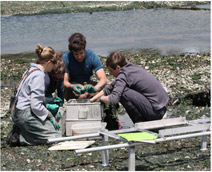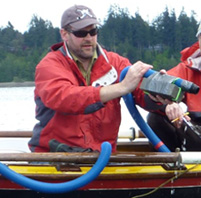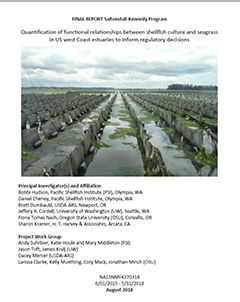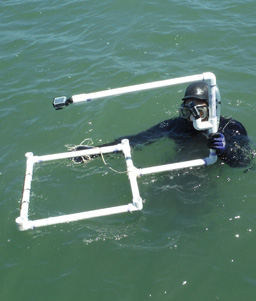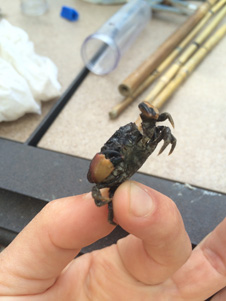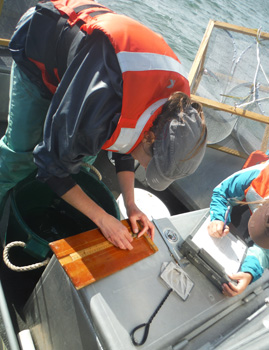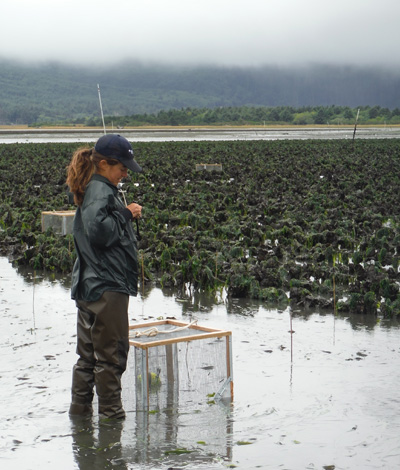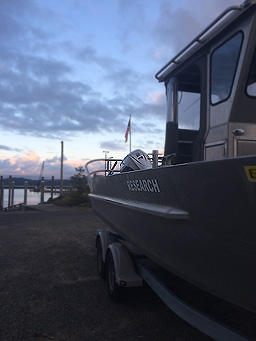|
Estuarine habitats, such as seagrass or “eelgrass” communities serve as critical refugia and feeding grounds for a diverse array of juvenile fish and invertebrate species, including endangered salmonids and economically important crab species. Current environmental regulations aimed at protecting estuarine habitats for endangered and threatened species have been hindering the expansion of shellfish aquaculture. Provisions under state and federal regulations that include no-net-loss of native seagrasses (primarily, Zostera marina) to protect essential fish habitat have led managers to take a precautionary approach when approving activities that may have a direct impact on these habitats. Managers have little information regarding environmental impact of shellfish culture on estuarine habitats and processes, while scientific studies documenting ecosystem services of shellfish culture within estuarine environments are limited.
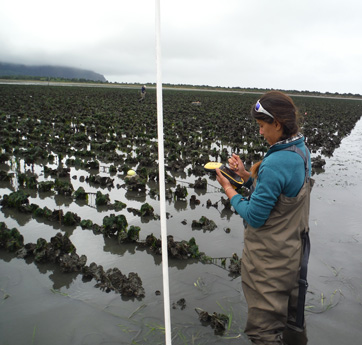
OSU Biology Intern, Keala records GPS coordinates to map eelgrass distribution at survey sites in Tillamook, OR.
The overall goals of this research aim to expand opportunities for shellfish aquaculture on the west coast of the U.S., while maintaining and improving estuarine conditions for other managed fish and invertebrate species. This study will fill site-specific gaps to value the habitat function of native eelgrass and shellfish culture in WA, OR and Northern CA estuaries. The results from this study will elucidate actual versus perceived environmental effects of shellfish culture on eelgrass communities and estuarine processes, which will aid managers in the decision making and permitting process involving shellfish culture and will allow for more targeted conservation efforts.
Habitat use by estuarine fish and epibenthic invertebrates will be compared across three distinct habitats for this study: structure provided by native eelgrass, structure provided by oyster aquaculture and habitat at the intersection of these two communities in four west coast estuaries -- Willapa and Samish Bay, WA, Tillamook, OR, and Humboldt Bay, CA. The research team will create GIS data layers mapping the spatial distribution of seagrasses and existing shellfish culture for each site. Predictive models will be developed to assess overlap and change analyses of seagrass in relation to proposed shellfish culture.

UW scientist, Jason Toft assesses percent cover along one of the eelgrass transects in Willapa Bay, WA.
The core research team includes: Bobbi Hudson (PI) and Daniel Cheney at the Pacific Shellfish Institute, Brett Dumbauld at USDA-ARS, Newport, OR, Jeff Cordell from the University of Washington, Fiona Tomas Nash from Oregon State University and H.T. Harvey & Associates, Arcata, CA. This work is supported by the NOAA Saltonstall-Kennedy Program (grant no. 2004246).
Project Deliverables:
Year 1
GIS data layers mapping the spatial distribution of seagrasses and existing shellfish culture will be developed for each site
Predictive models will be developed from this data to be used as tools to assess overlap and change analyses of seagrass in relation to proposed shellfish culture
Year 2
Analyses of seagrass habitat inside and outside shellfish farms at common tidal elevations
Fish/invertebrate use data across habitat and culture type complete
Project results reported in scientific journals and presented at annual meetings
Results will be used to inform the Humboldt Bay Harbor District's pre‐permitting process

Scientists from UW use an epibenthic pump to sample small invertebrates living on the sediment surface.
Partners:
Relevant Info:
Project Summary (printable 1-pg PDF) |








